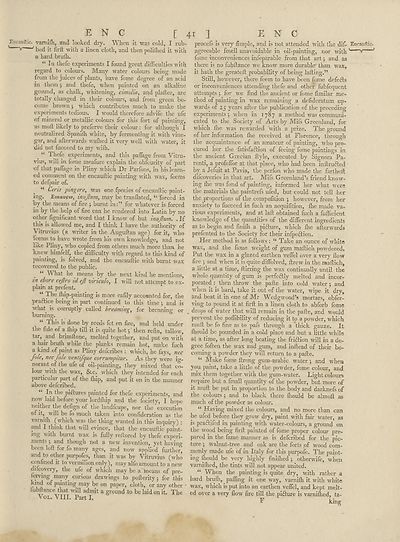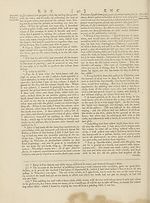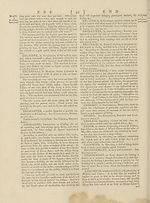Encyclopaedia Britannica, or, a Dictionary of arts, sciences, and miscellaneous literature : enlarged and improved. Illustrated with nearly six hundred engravings > Volume 8, ELE-FOR
(53) Page 41
Download files
Complete book:
Individual page:
Thumbnail gallery: Grid view | List view

E N C
Encauftic. vamxfJi, and looked dry. When it was cold,
bed it firft with a linen cloth, and then poliflied it with
a hard brufli.
“ In thefe experiments I found great difficulties with
regard to colours. Many water colours being made
from the juices of plants, have fome degree of an acid
in them ; and thefe, when painted on an alkaline
ground, as chalk, whitening, cimolia, and plafter, are
totally changed in their colours, and from green be¬
come brown j which contributes much to make the
experiments tedious. I would therefore advife the ufe
of mineral or metallic colours for this fort of painting,
as mo ft likely to preferve their colour : for although I
neutralized Spanith white, by fermenting it with vine¬
gar, and afterwards waftied it very well with water, it
did not fucceed to my with.
. “ Thefe experiments, and this paffiage from Vitru¬
vius, will in fome meafure explain the obfeurity of part
of that paffiage in Pliny which Dr Parfons, in his learn¬
ed comment on the encauftic painting with wax, feems
to defpair of.
“ Ceris ping ere, was one fpecies of encauftic paint¬
ing. Es/jMct/s-av, inujiwm, may be tranflated, “ forced in
”by the means of fire j burnt in :” for whatever is forced
in by the help of fire can be rendered into Latin by no
other fignificant word that I know of but inujlum. . If
this is allowed me, and I think I have the authority of
Vitruvius (a writer in the Auguftan age) for it, who
feems to have wrote from his own knowledge, and not
like Pliny, who copied from others much more than he
knew himfelf, the difficulty with regard to this kind of
painting, is folved, and the encauftic with burnt wax
recovered to the public.
V hat he means by the next kind he mentions,
m chore cejiro id ejl viriculo, I will not attempt to ex¬
plain at prefent.
“ The ftiip-painting is more eafily accounted for, the
praflice being in part continued to this time ; and is
what is corruptly called breaming, for brenning or
burning.
“ 1 his is done by reeds fet on fire, and held under
the fide of a (hip till it is quite hot j then refin, tallow,
tar, and brimftone, melted together, and put on with
a hair brufli while the planks remain hot, make fuch
a kind of paint as Pliny deferibes : which, he fays, nec
foie, nec fide ventifque corrumpitur. As they were ig¬
norant of the ufe of oil-painting, they mixed that co¬
lour with the wax, &e. which they intended for each
particulai part of the flup, and put it on in the manner
above deferibed.
“ ^ the pictures painted for thefe experiments, and
now laid before your lordftiip and the fociety, I hope
neither the defign of the landfcape, nor the execution
of it, will be fo much taken into confideration as the
varnifli (which was the thing wanted in this inquiry) :
and I think that will evince, that the encauftic paint¬
ing with burnt wax is fully reftored by thefe experi¬
ments 5 and though not a new invention, yet having
been loft for fo many ages, and now applied further,
and to other purpofes, than it was by Vitruvius (who
confined it to vermilion only), may alfo amount to a new
difeovery, the ufe of which may be a means of pre-
ferving many curious drawings to pofterity; for this
[ 41 1 E N C
I rub- procefs is very Ample, and is not attended with the dif- Encauftic.
agreeable fmell unavoidable in oil-painting, nor with
fome inconveniences infeparable from that art; and as
there is no fubftance we know more durable than wrax,
it hath the greateft probability of being lafting.”
Still, however, there feem to have been fome defers
or inconveniences attending thefe and other fubfequent
attempts ; for we find the ancient or fome fimilar me*-
thod of painting in vrax remaining a defideratum up¬
wards of 25 years after the publication of the preceding
experiments •, when in 1787 a method wras communi¬
cated to the Society of Arts by Mifs Greenland, for
which (lie was rewarded with a prize. The ground
of her information Ihe received at Florence, through
the acquaintance -of an amateur of painting, who pro¬
cured her the fatisfaftion of feeing fome paintings in
the ancient Grecian ftyle, executed by Signora Pa-
renti, a profeflor at that place, who had been inftrueted
by a Jefuit at Pavia, the perfon who made the farthert
difeoveries in that art. Mifs Greenland’s friend know¬
ing Are was fond of painting, informed her what were
the materials the paintrefs ufed, but could not tell her
the proportions of the compofition j however, from her
anxiety to fucceed in fuch an acquifition, ftie made va¬
rious experiments, and at laft obtained fuch a fufficient
knowledge of the quantities of the different ingredients
as to begin and finifli a picture, which flie afterwards
prefented to the Society for their infpeciion.
Her method is as follows : “ Take an ounce of white
wax, and the fame weight of gum maftich powdered-.
Put the wax in a glazed earthen veffel over a very flow
fire 5 and when it is quite diffolved, ftrew in the maftich,
a little at a time, ftirring the wax continually until the
whole quantity of gum is perfectly melted and incor¬
porated : then throrv the pafte into cold water 5 and
when it is hard, take it out of the water, wipe it dry,
and beat it in one of Mr Wedgwood’s mortars, obfer-
ving to pound it at firft in a linen cloth to abforb fome
drops of water that will remain in the pafte, and would
prevent the poffibility of reducing it to a powder, which
muft be fo fine as to pafs through a thick gauze. It
ffiould be pounded in a cold place and but a little while
at a time, as after long beating the friftion will in a de¬
gree^ foften the wax and gum, and inftead of their be¬
coming a powder they will return to a pafte.
“ Make fome ftrong gum-arabic water j and when
you paint, take a little of the powder, fome colour, and
mix them together with the gum-water. Light colours
require but a fmall quantity of the powder, but more of
it muft be put in proportion to the body and darknefs of
the colours 5 and to black there fliould be almoft as
much of the powder as colour.
“ Having mixed the colours, and no more than can
be ufed. before they grow dry, paint with fair water, as
is pra&ifed in painting with water-colours, a ground on
the wood being firft painted of fome proper colour pre¬
pared in the fame manner as is deferibed for the pic¬
ture ; Walnut-tree and oak are the forts of wood com¬
monly made ufe of in Italy for this purpofe. The paint¬
ing ffiould be very highly finiffied 5 otherwife, when
varniftied, the tints will not appear united.
“ When the painting is quite dry, with rather a
e; 1 1 —" r-" j > ^ hai'd brufli, palling it oneway, varniffi it with white
.-in" F“n may .° on PaPe^ cloth, or any other * wax, which is put into an earthen veffel, and kept melt-
Vol VIII ^Part^11 a gr0Und t0 bc laid °n it;* The ed over a very flow fire till the pi&ure is varnilhed, ta-
F king
Encauftic. vamxfJi, and looked dry. When it was cold,
bed it firft with a linen cloth, and then poliflied it with
a hard brufli.
“ In thefe experiments I found great difficulties with
regard to colours. Many water colours being made
from the juices of plants, have fome degree of an acid
in them ; and thefe, when painted on an alkaline
ground, as chalk, whitening, cimolia, and plafter, are
totally changed in their colours, and from green be¬
come brown j which contributes much to make the
experiments tedious. I would therefore advife the ufe
of mineral or metallic colours for this fort of painting,
as mo ft likely to preferve their colour : for although I
neutralized Spanith white, by fermenting it with vine¬
gar, and afterwards waftied it very well with water, it
did not fucceed to my with.
. “ Thefe experiments, and this paffiage from Vitru¬
vius, will in fome meafure explain the obfeurity of part
of that paffiage in Pliny which Dr Parfons, in his learn¬
ed comment on the encauftic painting with wax, feems
to defpair of.
“ Ceris ping ere, was one fpecies of encauftic paint¬
ing. Es/jMct/s-av, inujiwm, may be tranflated, “ forced in
”by the means of fire j burnt in :” for whatever is forced
in by the help of fire can be rendered into Latin by no
other fignificant word that I know of but inujlum. . If
this is allowed me, and I think I have the authority of
Vitruvius (a writer in the Auguftan age) for it, who
feems to have wrote from his own knowledge, and not
like Pliny, who copied from others much more than he
knew himfelf, the difficulty with regard to this kind of
painting, is folved, and the encauftic with burnt wax
recovered to the public.
V hat he means by the next kind he mentions,
m chore cejiro id ejl viriculo, I will not attempt to ex¬
plain at prefent.
“ The ftiip-painting is more eafily accounted for, the
praflice being in part continued to this time ; and is
what is corruptly called breaming, for brenning or
burning.
“ 1 his is done by reeds fet on fire, and held under
the fide of a (hip till it is quite hot j then refin, tallow,
tar, and brimftone, melted together, and put on with
a hair brufli while the planks remain hot, make fuch
a kind of paint as Pliny deferibes : which, he fays, nec
foie, nec fide ventifque corrumpitur. As they were ig¬
norant of the ufe of oil-painting, they mixed that co¬
lour with the wax, &e. which they intended for each
particulai part of the flup, and put it on in the manner
above deferibed.
“ ^ the pictures painted for thefe experiments, and
now laid before your lordftiip and the fociety, I hope
neither the defign of the landfcape, nor the execution
of it, will be fo much taken into confideration as the
varnifli (which was the thing wanted in this inquiry) :
and I think that will evince, that the encauftic paint¬
ing with burnt wax is fully reftored by thefe experi¬
ments 5 and though not a new invention, yet having
been loft for fo many ages, and now applied further,
and to other purpofes, than it was by Vitruvius (who
confined it to vermilion only), may alfo amount to a new
difeovery, the ufe of which may be a means of pre-
ferving many curious drawings to pofterity; for this
[ 41 1 E N C
I rub- procefs is very Ample, and is not attended with the dif- Encauftic.
agreeable fmell unavoidable in oil-painting, nor with
fome inconveniences infeparable from that art; and as
there is no fubftance we know more durable than wrax,
it hath the greateft probability of being lafting.”
Still, however, there feem to have been fome defers
or inconveniences attending thefe and other fubfequent
attempts ; for we find the ancient or fome fimilar me*-
thod of painting in vrax remaining a defideratum up¬
wards of 25 years after the publication of the preceding
experiments •, when in 1787 a method wras communi¬
cated to the Society of Arts by Mifs Greenland, for
which (lie was rewarded with a prize. The ground
of her information Ihe received at Florence, through
the acquaintance -of an amateur of painting, who pro¬
cured her the fatisfaftion of feeing fome paintings in
the ancient Grecian ftyle, executed by Signora Pa-
renti, a profeflor at that place, who had been inftrueted
by a Jefuit at Pavia, the perfon who made the farthert
difeoveries in that art. Mifs Greenland’s friend know¬
ing Are was fond of painting, informed her what were
the materials the paintrefs ufed, but could not tell her
the proportions of the compofition j however, from her
anxiety to fucceed in fuch an acquifition, ftie made va¬
rious experiments, and at laft obtained fuch a fufficient
knowledge of the quantities of the different ingredients
as to begin and finifli a picture, which flie afterwards
prefented to the Society for their infpeciion.
Her method is as follows : “ Take an ounce of white
wax, and the fame weight of gum maftich powdered-.
Put the wax in a glazed earthen veffel over a very flow
fire 5 and when it is quite diffolved, ftrew in the maftich,
a little at a time, ftirring the wax continually until the
whole quantity of gum is perfectly melted and incor¬
porated : then throrv the pafte into cold water 5 and
when it is hard, take it out of the water, wipe it dry,
and beat it in one of Mr Wedgwood’s mortars, obfer-
ving to pound it at firft in a linen cloth to abforb fome
drops of water that will remain in the pafte, and would
prevent the poffibility of reducing it to a powder, which
muft be fo fine as to pafs through a thick gauze. It
ffiould be pounded in a cold place and but a little while
at a time, as after long beating the friftion will in a de¬
gree^ foften the wax and gum, and inftead of their be¬
coming a powder they will return to a pafte.
“ Make fome ftrong gum-arabic water j and when
you paint, take a little of the powder, fome colour, and
mix them together with the gum-water. Light colours
require but a fmall quantity of the powder, but more of
it muft be put in proportion to the body and darknefs of
the colours 5 and to black there fliould be almoft as
much of the powder as colour.
“ Having mixed the colours, and no more than can
be ufed. before they grow dry, paint with fair water, as
is pra&ifed in painting with water-colours, a ground on
the wood being firft painted of fome proper colour pre¬
pared in the fame manner as is deferibed for the pic¬
ture ; Walnut-tree and oak are the forts of wood com¬
monly made ufe of in Italy for this purpofe. The paint¬
ing ffiould be very highly finiffied 5 otherwife, when
varniftied, the tints will not appear united.
“ When the painting is quite dry, with rather a
e; 1 1 —" r-" j > ^ hai'd brufli, palling it oneway, varniffi it with white
.-in" F“n may .° on PaPe^ cloth, or any other * wax, which is put into an earthen veffel, and kept melt-
Vol VIII ^Part^11 a gr0Und t0 bc laid °n it;* The ed over a very flow fire till the pi&ure is varnilhed, ta-
F king
Set display mode to:
![]() Universal Viewer |
Universal Viewer | ![]() Mirador |
Large image | Transcription
Mirador |
Large image | Transcription
Images and transcriptions on this page, including medium image downloads, may be used under the Creative Commons Attribution 4.0 International Licence unless otherwise stated. ![]()
| Permanent URL | https://digital.nls.uk/192264108 |
|---|
| Attribution and copyright: |
|
|---|
| Description | Ten editions of 'Encyclopaedia Britannica', issued from 1768-1903, in 231 volumes. Originally issued in 100 weekly parts (3 volumes) between 1768 and 1771 by publishers: Colin Macfarquhar and Andrew Bell (Edinburgh); editor: William Smellie: engraver: Andrew Bell. Expanded editions in the 19th century featured more volumes and contributions from leading experts in their fields. Managed and published in Edinburgh up to the 9th edition (25 volumes, from 1875-1889); the 10th edition (1902-1903) re-issued the 9th edition, with 11 supplementary volumes. |
|---|---|
| Additional NLS resources: |
|

